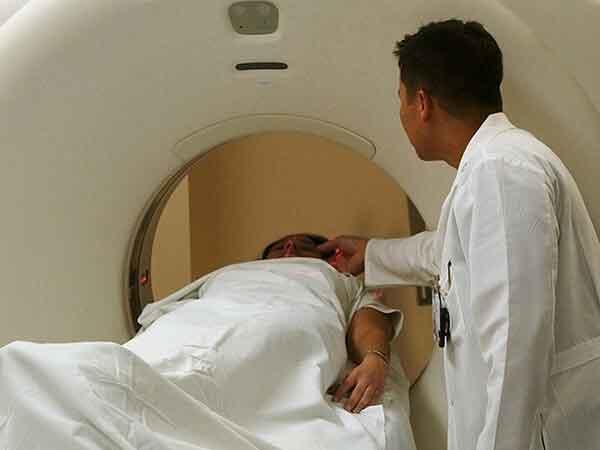Enhanced Risk-Based Lung Cancer Screening May Prevent More Deaths than Current Approaches
, by NCI Staff
NCI researchers have developed a risk model-based approach for selecting smokers and former smokers who may be candidates for lung cancer screening with low-dose computed tomography (CT). Using data from two lung cancer screening studies and a U.S. health survey, the researchers estimated that the new approach might prevent more deaths from lung cancer over 5 years than would current screening recommendations.
Results from the statistical analysis appeared in JAMA on May 15.
The researchers developed and validated statistical models that identify smokers and former smokers who, based on an analysis of multiple risk factors for lung cancer, are at the highest risk of dying from the disease. The models take into account detailed information about all known risk factors, including age, smoking history, race, sex, body mass index, education, family history of lung cancer, and whether the person has emphysema.
“Our findings suggest that individualized risk assessments could not only help us avoid more lung cancer deaths but may also improve the effectiveness and efficiency of screening over current approaches,” said the study’s first author, Hormuzd Katki, Ph.D., of NCI’s Division of Cancer Epidemiology and Genetics.
Reducing Lung Cancer Deaths
Screening with low-dose CT scans was shown to lower the risk of dying from lung cancer among heavy smokers in the National Lung Screening Trial (NLST). The trial demonstrated a 20% reduction in lung cancer mortality among heavy smokers who received annual CT scans over 3 years, as compared with deaths among participants screened with a standard chest x-ray.
Based on the trial results and additional modeling studies, the U.S. Preventive Services Task Force (USPSTF) recommends annual CT screening for individuals between 55 and 80 years old with a history of heavy smoking (at least one pack of cigarettes per day for 30 years or more) and who currently smoke or have quit within the past 15 years.
In a previous analysis of NLST data, NCI researchers reported that CT screening prevented the greatest number of deaths from lung cancer among participants who were estimated to be at the highest risk and prevented very few deaths among those estimated to be at lowest risk. An individualized risk-based approach that further stratifies eligible smokers might better identify who will get the most benefit, noted Dr. Katki.
Testing the Models
To evaluate this strategy, the researchers compared it with the approach recommended by the USPSTF using risk models developed with data from the Prostate, Lung, Colorectal and Ovarian Cancer Screening Trial (PLCO). They validated the models using data from PLCO, NLST, and the National Health Interview Survey.
The authors estimate that 9 million current and former smokers meet the USPTF criteria, and that CT screening might prevent approximately 46,000 deaths from lung cancer over 5 years.
However, the study authors found that the enhanced risk-based approach to select screening candidates from the same 9 million “ever-smokers” might increase the number of lung cancer deaths prevented by approximately 20%—to an estimated 56,000 deaths prevented over 5 years.
The researchers also estimated that the risk-based approach might improve lung cancer screening by two common measures of screening efficacy: decreasing the number of people who need to be screened to prevent one death (from 194 to 162) and reducing the number of false-positive test results per prevented death (from 133 to 116).
The risk-based screening strategy may perform better than USPSTF recommendations, the study authors noted, in part because it identifies high-risk individuals who may benefit from, but are not currently eligible for, screening. This group includes people who have smoked less than one pack of cigarettes per day for decades and very heavy smokers who quit more than 15 years ago.
In addition, the approach may identify individuals who are eligible based on age and smoking history alone but are at low risk of lung cancer and may benefit little from screening.
“The findings are provocative and support the notion that an enhanced risk-based approach to screening is potentially more effective and more efficient than performing a risk assessment based only on age and smoking history,” wrote Michael K. Gould, M.D., of Kaiser Permanente Southern California in an accompanying editorial.
Looking Ahead
In clinical practice, Dr. Gould noted, “the decision to screen is very personal and should be individualized for each patient.” Doctors and patients need reliable information about the risks and potential benefits of lung cancer screening, he wrote. Among the risks is the potential for false-positive results that may lead to additional tests and unnecessary surgeries.
The study authors cautioned that their estimates are based on statistical models rather than on observed outcomes. The models involve certain assumptions about implementation of the risk-based screening strategy, and more research would be needed to determine the most effective way to implement the strategy, they wrote.
The study authors also noted that most deaths from lung cancer cannot be prevented by CT screening.
“The best way for smokers to reduce their risk of developing lung cancer—and all smoking-related illnesses—is to quit smoking as early as possible,” said Dr. Katki.
